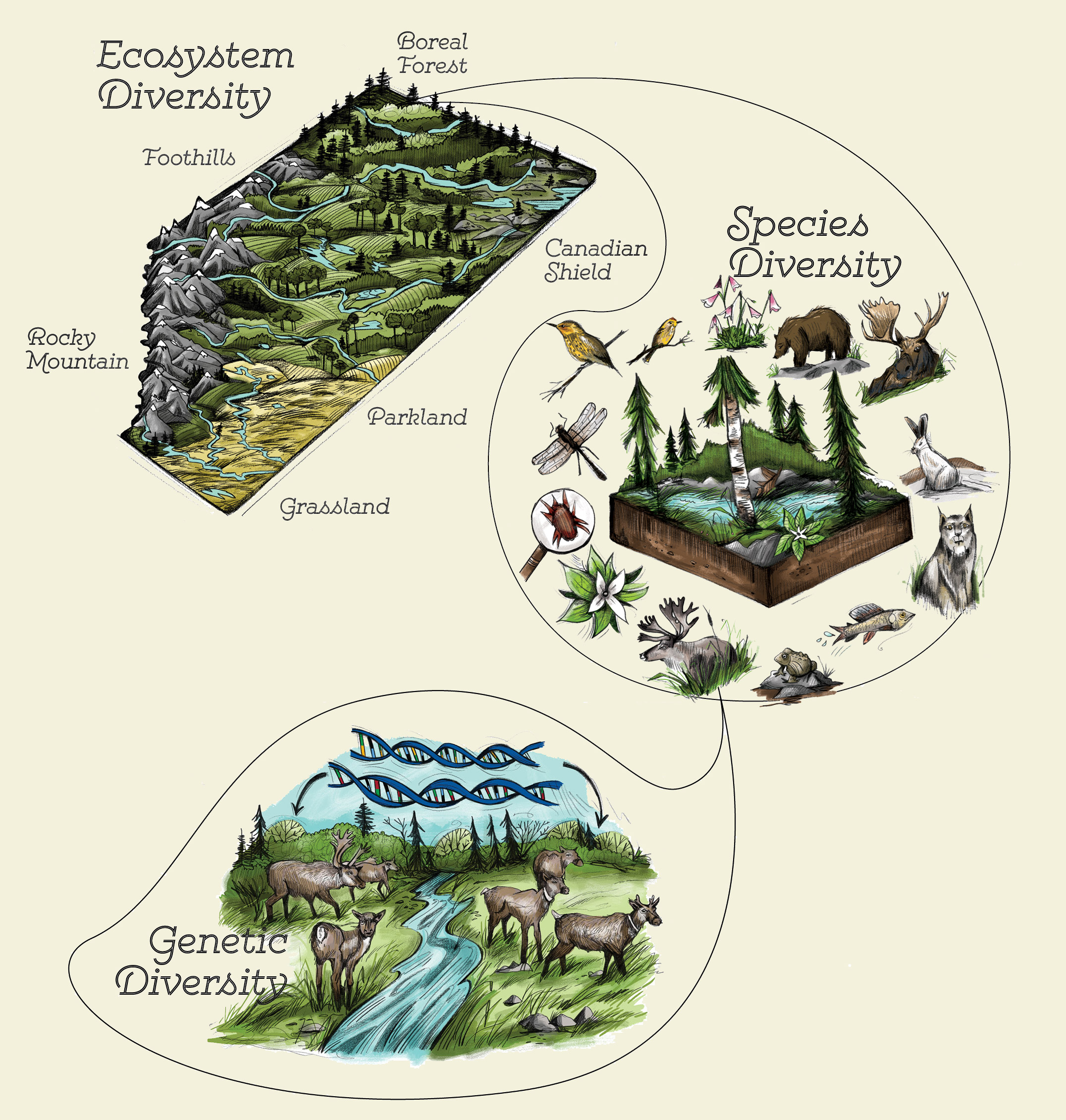CBSE Class 12 Biology Chapter 15 Revision Notes
Chapter 15: Biodiversity Revision Notes
What is Biodiversity?
- Biodiversity is a term popularized by sociobiologist Edward Wilson.
- It describes the combined diversity at all levels of biological classification such as genetic, species, and ecological diversity.
- Millions of years of evolution are responsible for accumulating this rich diversity in nature.
Important Types of Diversity:
Genetic diversity:
A single species can show high genetic diversity over its range of distribution, for example, woodpeckers can come in different colours, shapes, and sizes within a specific habitat!
Some examples in India are:
- The genetic variation shown by the plant Rauwolfia vomitoria in the potency and concentration of reserpine.
- 50,000 genetically different strains of rice in India
- Over 1000 mango varieties in India 🥭
Species diversity:
- Is the total number of species within the area.
- For example, the Western Ghats have a greater amphibian species diversity than the Eastern Ghats.
Ecological diversity:
- It is the total number of ecosystems in the region such as deserts, rain forests, mangroves, coral reefs, wetlands, and estuaries.

Biodiversity on Earth
- The total number of plant and animal species in the world is slightly more than 1.5 million [IUCN (2004)] and many species remain to be discovered!
- Robert May places the global species diversity at about 7 million.
- Animals comprise more than 70 percent of all the species recorded, with insects making up more than 70 percent of the total animals.
- More than 22 percent of the total includes plants (including algae, fungi, bryophytes, gymnosperms, and angiosperms).
- The number of fungi species in the world outnumbers the combined total of the species of fishes, amphibians, reptiles, and mammals.
- Due to difficulties in identifying microbial species the estimates do not give any figures for prokaryotes.

How Many Species Are in India?
- Nearly 45,000 species of plants and twice as many animals are found in India.
- It accounts for 8.1 percent of global species diversity, making India one of the 12 mega diversity countries of the world.
- There are potentially 1 lakh plant species and 3 lakh animal species that are yet to be discovered.
Patterns of Biodiversity
The worldwide distribution of plant and animal diversity is uneven! Many groups of plants and animals show interesting diversity patterns. Let us look at a few:
Latitudinal Diversity Gradient
- Biodiversity across the globe tends to be highest at the equator and diminishes as one moves towards the poles – this pattern is called the latitudinal diversity gradient
- There are a larger number of species in the tropics as compared to the temperate and polar regions. For example, Colombia (near the equator) harbours almost 1400 bird species, whereas New York City, has only 105 species in comparison!
- A few advantages that the tropics have in terms of diversity are:
- Undisturbed environments: Tropical environments have been relatively undisturbed for millions of years and have provided adequate years for evolutionary speciation to occur.
- Less seasonal: A constant and predictable tropical environment helps promote niche specialisation.
- Higher solar energy: Abundant solar energy at the equatorial regions enhances productivity and contributes to greater diversity.

Example of the current latitudinal biodiversity gradient showing high concentration of diversity near the equator (closer to the red end of the colour spectrum), declining toward the poles (closer to the blue end of the colour spectrum)
Source: Mannion et al. 2014
Species – Area Relationship
- German naturalist Alexander von Humboldt observed that species richness within a region increased with increasing explored area but only up to a limit.
- This relationship between species richness and area is well known in ecology and is seen to be a rectangular hyperbola!
- The species-area relationship can be described by the following equation: log S = log C + Zlog A where S = species richness, A = area, Z = slope of the line (regression coefficient), C = Y-intercept

Source: McLachlan et al. 2018
Why is Species Diversity so Important?
- David Tilman’s long-term ecosystem experiments using outdoor plots hope to explain the connection between species richness and a stable community
- Tilman’s plots showed less year-to-year variation in total biomass with more species. His experiments also noted that increased diversity contributed to higher productivity.

- Rich biodiversity is essential for an ecosystems health and also for human survival as we depend on nature for food, fuel, shelter, and medicine.

Sources
Biology Textbook for Class XII. National Council for Educational Research and Training. 2021-2022
]]>
